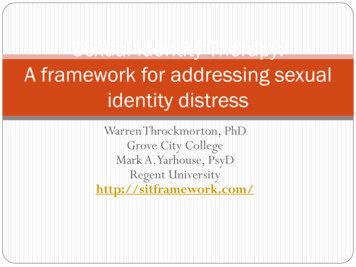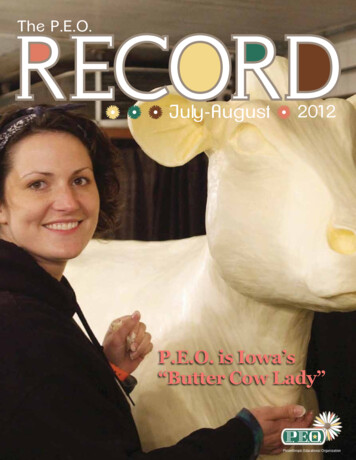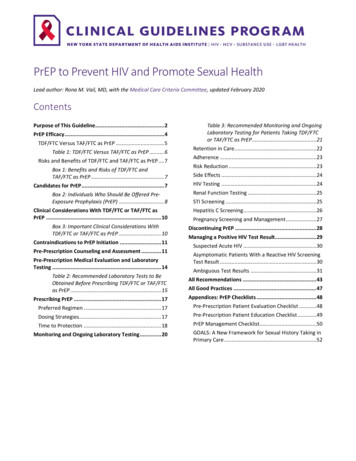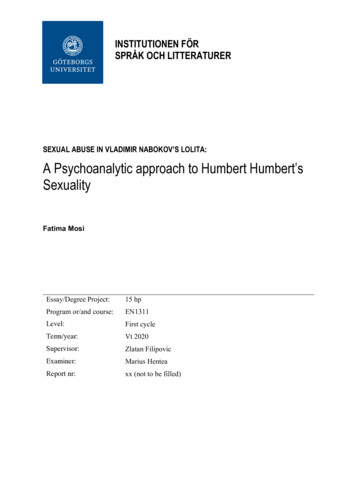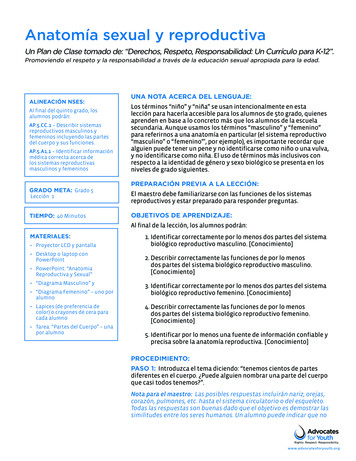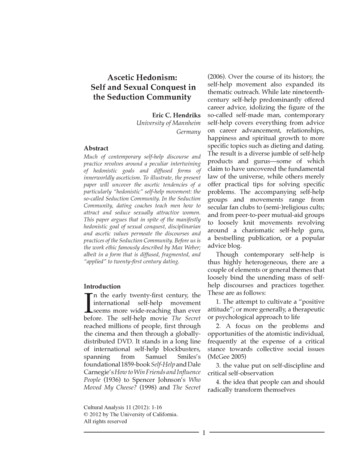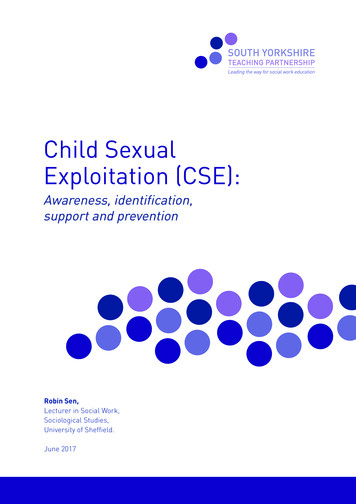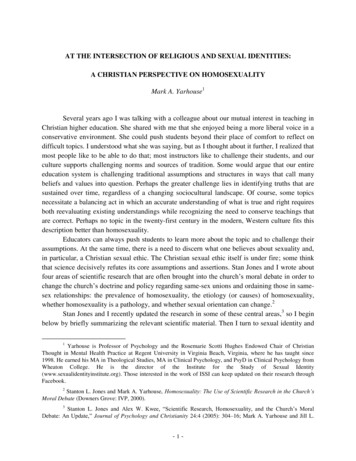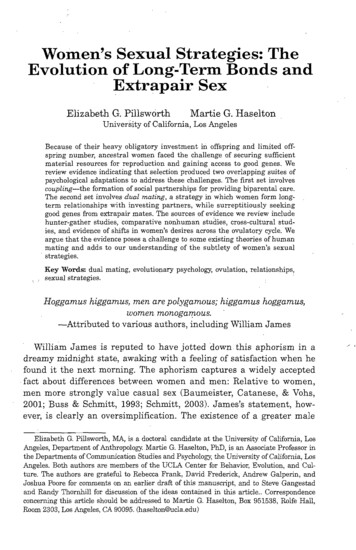
Transcription
Women's Sexual Strategies: TheEvolution of Long-Term Bonds andExtrapair SexElizabeth G. PillsworthMartie G. HaseltonUniversity of California, Los AngelesBecause of their heavy obligatory investment in offspring and limited off spring number, ancestral women faced the challenge of securing sufficientmaterial resources for reproduction and gaining access to good genes. Wereview evidence indicating that selection produced two overlapping suites ofpsychological adaptations to address these challenges. The first set involvescoupling-the formation of social partnerships for providing biparental care.The second set involves dual mating, a strategy in which women form long term relationships with investing partners, while surreptitiously seekinggood genes from extrapair mates. The sources of evidence we review includehunter-gather studies, comparative nonhuman studies, cross-cultural stud·ies, and evidence of shifts in women's desires across the ovulatory cycle. Weargue that the evidence poses a challenge to some existing theories of humanmating and adds to our understanding of the subtlety of women's sexualstrategies.Key Words: dual mating, evolutionary psychology, ovulation, relationships,sexual strategies.Hoggamus higgamus, men are polygamous; higgamus hoggamus,women monoga71Jous.-Attributed to various authors, including William JamesWilliam James is reputed to have jotted down this aphorism in adreamy midnight state, awaking with a feeling of satisfaction when hefound it the next morning. The aphorism captures a widely accepted.fact about differences between women and men: Relative to women,men more strongly value casual sex (Baumeister, Catanese, & Vohs,2001; Buss & Schmitt, 1993; Schmitt, 2003). James's statement, how ever, is dearly an oversimplification. The existence of a greater maleElizabeth G. Pillsworth, MA, is a doctoral candidate at the University of California, LosAngeles, Department of Anthropology. Martie G. Haselton, PhD, is an .!\ssociate Professor inthe Departments of Communication Studies and Psychology, the University of California, LosAngeles. Both authors are members of the UCLA Center for Behavior, Evolution, and Cul ture. The authors are grateful to Rebecca Frank, David Frederick, Andrew Galperin, andJoshua Poore for comments on an earlier draft of this manusclipt, and to Steve Gangestadand Randy Thornhill for discussion of the ideas contained in this article. Correspondenceconcerning this article should be addressed to Martie G. Haselton, Box 951538, Rolfe Hall,Room 2303, Los Angeles, CA 90095. (haselton Ucla.edul
60E. PILLSWORTH & M. HASELTONdesire for casual sex does not mean that women are "monogamous" andmen are not. There is abundant evidence that women, as well as men,desire long-term committed relationships; but there is also an emergingliterature revealing a hidden side of women's desires suggesting thatwomen have also evolved to pursue short-term or illicit affairs. The pur pose of this article is to review these lines of evidence and other recentfindings pertaining to the evolution of women's sexual strategies.l\.lthough humans are unique among other animals because of thediversity of their sexual behaviors (Dixson, 1998; Kinsey, Pomeroy, &Martin, 1948; Kinsey, Pomeroy, Martin, & Gebhard, 1953), we arguethat a great deal of the evidence indicates two overlapping suites of psy chological adaptations in women: those for securing long-term, coopera tive social partnerships for rearing children and those for pursuing a"dual-mating strategy" in which women secure a social partner andengage in selective sexual affairs to gain access to good genes for off spring.The Evolutionary Psychological ApproachThe perspective we have taken in writing this review is that -of evolu tionary psychology. Evolutionary psychology is founded on the idea thatan explicit consideration of the adaptive problems faced by our ancestorscan lead to new discoveries and can organize and explain existing knowl edge. We use this perspective as a framework for understanding the lit erature, and thus we begin by discussing recurrent features of the socialand physical environment in which human mating strategies evolved,and we organize empirical discoveries in terms of the adaptations thatmay have evolved in response to these environmental challenges.There are several core assumptions of evolutionary psychology thatbear on our analysis. First, the working hypothesis of most evolutionary .psychologists is that the mind contains many specialized adaptationsakin to the different organs of the body (Barrett & Kurzban, 2006; Buss,1995; Tooby & Cosmides, 1992); each organ in the body has a specificfunction, and so too should the mechanisms of the mind. Because mat ing decisions playa central role in reproduction, and thus in humanevolution, our expectation is that there will be many richly specifiedadaptations underlying women's sexual behavior. Indeed, some of thebest evidence supporting this expectation includes recent discoveries ofspecific changes in women's preferences and behaviors across the men strual cycle, and this evidence plays a key role in our review.A second assumption is that the mechanisms of the mind were forgedby natural selection operating over hundreds of thousands of years, and
WOMEN'S SEXUAL STRATEGIES61thus there will sometimes be mismatches between the outputs of theseevolved mechanisms and the challenges present in the modern world.For example, humans have a well-documented tendency to easilydevelop fears of snakes and spiders, but not of some modern dangersthat are much more perilous, such as fast moving automobiles (Ohman& Mineka, 2001). Another example is our preference for foods high insugar, salt, and fat (Pinel, Assanand, & Lehman, 2000). In the ancestralenvironment, where food availability was unreliable, this preferenceprobably helped to ward off starvation; in the modern world, these pref erences lead to afilictions such as heart disease and diabetes. Humansexual behaviors were also forged in environments that were differentin many ways from the environment oftoday. The availability of reliablecontraception and technologies that assist in reproduction, for example,are modern inventions, and thus one would not expect psychologicaladaptations to have evolved to take into account the contingencies theypresent. Thus, although contraception has given women more practicalfreedom, women's minds may still treat sex as if it would have thereproductive consequences it had in ancestral conditions.Lastly, the criterion for selection was reproductive success-how wellthe bearer of an adaptation and her descendants reproduced-regard less of how happy, well-adjusted, or even how healthy this made her.Thus, the g?als women seek to achieve in their lives today, includingtheir own subjective happiness, may not be served well by evolved 1:l:dap tations. One possibility in presenting this evolutionary analysis of mat ing adaptations is that women may come to better understand the logicof their desires and perhaps make more informed decisions aboutwhether to follow them.The Evolution of Mating StrategiesParental Investment TheoryTrivers's theory of parental investment proposes that males andfemales in sexually reproducing species should possess somewhat differ ent psychological adaptations surrounding sex and mating (Trivers,1972). Parental investment is investment in producing or caring for off spring. Investment in one offspring reduces the budget remaining forallocation to others, including future offspring. Human females, like thefemales of most other species, must invest heavily in each child pro duced. The human 9-month pregnancy, longer than expected based onmammalian patterns of gestation length relative to body size, requiresan increase in caloric intake of 8%-10% (Dufour & Sauther, 2002). Lac tation, which among modern hunter-gatherers persists for an average of
62E. PILLSWORTH & M. HASELTON2.5 years (Lancaster, Kaplan, Hill, & Hurtado, 2000), is even moredemanding and can increase energetic needs by up to 26% (Dufour &Sauther, 2002). Males have a much smaller obligatory investment. Inprinciple, a human male can reproduce after investing only the time ittakes for a single act of copulation.Parental investment theory predicts that the higher investing sexshould be more selective than the lower investing sex in choosing matesand more restricted in sexual activity. Women's reproductive invest ments are heavy, and they are necessary for offspring survival; in sub sistence-level economies, for example, an infant orphaned by its motherbefore weaning is unlikely to survive (Hill & Hurtado, 1996; Mace,1999; Sear, Allal, & Mace, in press). The death of a father also impactschild survivorship but is much less likely to be fatal. Because of the crit role their investment plays in reproduction relative to that of men,women should exact high standards before choosing a mate.The lower investing sex, on the other hand, should be more open toopportunistic, low-investment matings. As Symons (1979) argued, anancestral man who secured even one additional mating outside of hislong-term relationship could have increased his reproductive successmarkedly, perhaps even by 50% or 100%. For women, increasing num bers of partners would not necessarily have increased offspring number;indeed, there were substantial costs that would have counteracted anybenefits of having more partners, including risks of contracting sexuallytransmitted diseases andthe wrath ofjealous partners.Men can and do investin their offspring,. however, and whenthey do so, they should also be highly selective in choosing mates (Ken rick, Sadalla, Groth, & Trost, 1990). Nonetheless, the difference inobligatory investment createsbetween the sexes, such thatwomen, on average, desire greater material investment from partnersthan do men, and men, on average, seek to increase their overall part ner number more so than do women.The Heavy Burden ofRaising a Human Child and the Need forBiparental CareHumans are unique among our closest living relatives, the great apesand other primates, in the sheer amount of parental investment that isnecessary to rear offspring to reproductive age, a situation that has ledto a somewhat uneasy alliance between women and men. As a point ofcomparison, chimpanzee offspring from birth are able to hold ontomothers' backs as they traverse the forest in search of food, are WE!arledat about 4 years of age, and are fully self-sufficient by about 5 years ofage. Chimpanzee mothers have only one offspring about every 5 years,
WOMEN'S SEXUAL STRATEGIES63thus rarely caring for more than one dependent offspring at a time(Lancaster et al., 2000; Silk, 1978). Female chimpanzees may some times attempt to get additional food resources from males in the troop,but they need not rely upon such resources to successfully raise theiroffspring, and it does not appear to be a significant factor in their repro ductive success (Hemelrijk, Meier, & Martin, 1999).Human offspring, on the other hand, are born relatively helpless,unable even to lift their own heads or unfold their hands until almostthe 3rd month of life, and they remain dependent on. their caregivers fora much longer time than any other primate. Among modern hunter gatherers, for example, children do not begin to produce as many calo ries as they consume until approximately 15 years of age (Hill &Hurtado, 1996; Lee & Kramer, 2002), remaining dependent during thattime on the provisioning of others. Human mothers in natural-fertilitycontexts (like those of most modern hunter-gather groups) wean theirchildren at approximately 2.5 years of age, and have one child every 3 to4 years (Lancaster et al., 2000; Mace, 1999; Panter-Brick, 1991)-amuch greater rate of reproduction than chimpanzees. Women thusspend much of their adult life caring for multiple dependent offspringsimultaneously, a commitment of time and energy unparalleled by anyother primate. The problem of finding enough resources to meet wom en's own needs and those of several dependent children is one of themajor challenges to reproductive success When children are ulllikely to survive without investment beyondwhat can be provided by mothers alone, there can be selection forfathers to also invest in their offspring (Birkhead & M ller, 1996; Geary,2000; Zeh & Smith, 1985). Human males are unique among the greatapes in the extent to which they invest in their mates and offspring(Geary, 2000; Marlowe, 2000, 2001). This investment, however, entails atradeoff, since a man who spends his time and energy providing pater nal care cannot spend that time and energy seeking additional matingopportunities. Because male investment is not biologically obligatory,men may engage in a variety of strategies designed to minimize theircosts while increasing their reproductive output, including fooling othermales into investing in their offspring through cuckoldry (Gangestad &Simpson, 2000), pursuing opportunistic low-investment mating oppor tunities either in place of or in addition to a long-term relationship(Buss & Schmitt, 1993; Clark & Hatfield, 1989; Symons, 1979), andabandoning current mates and existing children in order to pursueother mating opportunities, particularly as their partners age and theirfuture reproductive potential declines (Betzig, 1989). Because of theconflict for men between investing in parenting effort and mating effort,
64E. PILLSWORTH & M. HASELTONwomen face the threat of being left without the resources needed to suc cessfully raise their children. Ancestral women needed to be sensitive toand her children, and also howhow well a man could invest inlikely he would be to continue to do so for the duration of time it took toraise a child to maturity.Gaining Access to Good GenesGenetic benefits. Material resources and investments of time are not theonly factors affecting offspring. A child who is born weak or sickly, who isgenetically
The lower investing sex, on the other hand, should be more open to opportunistic, low-investment matings. As Symons (1979) argued, an ancestral man who secured even one additional mating outside of his long-term relationship could have increased his reproductive success markedly, perhaps even by 50% or 100%. For women, increasing num bers of partners would not necessarily have increased .
